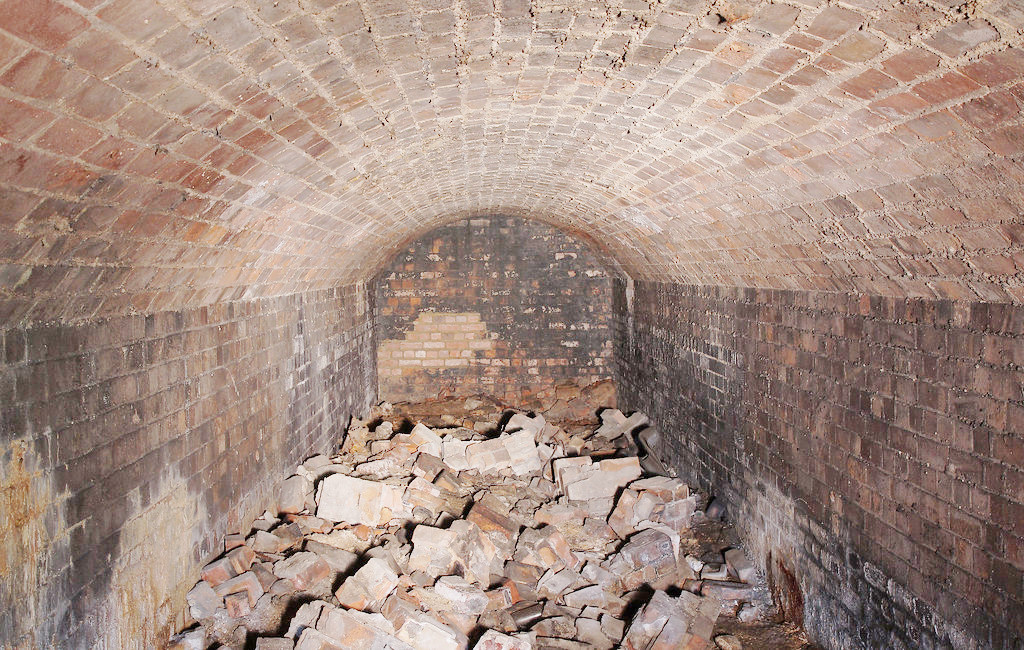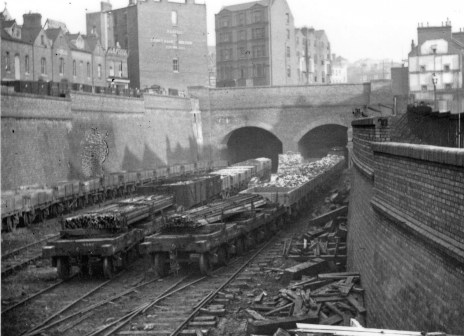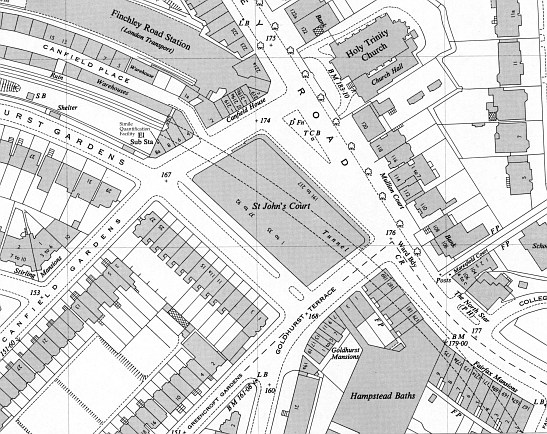
Canfield Place Simile Quantification Facility
This is a picture of the Simile Quantification Facility at Canfield Place, near Finchley Road station in Hampstead, London, immediately after a test shot. The purpose of the facility is to assist in determining whether a given simile is or is not appropriate for a given situation. Here, we see the results of an experiment to determine the precise degree of strength it is valid to infer from the description "built like a brick shithouse".

It can be seen that the experimental procedure in this case was to construct a specimen brick shithouse, in the rear left corner, and then test it to destruction. This experiment was at the end of the test series; it is the practice to perform tests in order of increasing energesis, to reduce the risk of an unexpectedly destructive instance causing damage sufficient to prevent completion of the series. Here, the testing of shithouses constructed with lesser degrees of robustness has been completed, and the picture shows the remains of a particularly sturdy structure, a fortified brick shithouse of unusually small internal volume and with unusually thick walls. At this point the limit of the capacity of this facility was reached, and the next series, of larger tests, was carried out at a different site.
Among the debris of the shithouse walls strewn across the chamber there are a few remains of the experimental apparatus, presumably items damaged beyond repair. In the middle at the front is some cylindrical object which might equally well be made of brown pottery or polished stainless steel, it not being possible to make the distinction from the photograph; and towards the back on the right is some object coated in a thick layer of brownish-grey muck - probably best not to inquire too closely as to what particular kind - which is a bit like the fairing off a Joe 90, only not like one. Also visible are a scrap of cabling, and what appears to be a stencilled marking D on a chunk of broken brickwork on the right.
Some idea of the amount of energy released in this test may be gained from the extent of the damage caused to the rear wall, now repaired with fresh bricks, and the small pile of bricks which have somehow been actually charred, against the wall on the right hand side. Much as an Axiom Testing Station is usually constructed in the desert to minimise such hazards as passers-by getting shot, facilities of this kind are so located as to avoid clobbering people with lumps of flying brickwork. This tunnel-shaped chamber is hidden underground, constructed within the bore of another much larger tunnel, thus leaving a space used for energy dispersal and repair access. The wisdom of this decision can be inferred from the brickwork of the roof, which is much cleaner than that of the walls due to the previous roof having been blown off entirely in an experiment to quantify the simile "goes up like a fucking rocket" (sadly, though predictably, no traces remained either of the rocket itself or of whoever it was fucking).

The London Extension of the Great Central Railway runs in a series of tunnels from Marylebone station out to Canfield Place, which is the name of a location tucked in behind the better-known Finchley Road Underground station, the point at which the Underground tracks themselves also emerge from tunnels. They were running out of money, they barely managed to build the extension at all, and what they ended up with at the London end was a bunch of bodges and compromises and awkward arrangements which were better than nothing but not by much; and the final section, from Canfield Place in to Marylebone ("Contract No. 7" as it was known) was the most expensive part of the whole operation. What they were actually able to build was quite a long way short of what they actually wanted, but they did make some attempt to at least get the most pain-in-the-arsey bits of what they didn't build over and done with while it was all dug up so they wouldn't have to dig it all up again later if they ever did manage to finish it off.
Because of the involvement of cricket, the inexplicable idiot nostalgia for Victorian pubic school culture among those who never experienced it, and the sheer bloody fuss about nothing that the MCC kicked up, it is reasonably well known that when they finally did get to dig up some non-playing ground at the east end of Lord's and build tunnels under it, they built three of them - two big ones and one bigger one - with a total capacity of seven tracks, of which two became the running lines and the rest were used as sidings and headshunts. It may have been a bit of an extravagant means of providing sidings and headshunts, but at least it meant that if ever they did manage to make a move on completing the originally intended capacity, at least they wouldn't have to deal with those fucking cricketing bastards again.
(Shame the evil destructive shitheads at Railtrack went and fucked that possibility to the wide by flogging the spare tunnels off to a bunch of parasitic capitalist wankers - some cunts called Rifkind who buy stuff up and make it get more expensive and then punt it on again, so they can suck the blood of the mugs who want to actually do something with it. Though it seems the MCC, who still own the bit of earth on top of the tunnels, are kicking up another fuss out of spite at not being able to get the tunnels cheap themselves, so with a bit of luck they will at least fuck up the bloodsuckers' plans even if they can't achieve anything productive.)

It is less well known that they had a similar problem at the northern end of the works, needing to tunnel under the Hampstead Baths (which had only been built about ten years before), because only plebs use them. It is also a lot harder to find out any details of exactly what they did about it. They did certainly build the baths a posh new front, though it is not clear whether that was part of a deal to be allowed to build the tunnel or just something they had to do because the old front fell down on them. The block on the other side of Goldhurst Terrace, labelled "St John's Court" on the map, which at the time was a row of shops called Fitzjohn's Parade, apparently did fall down; at least, the story begins with them trying to underpin it, and ends with them having "rebuilt it on top of the tunnel", so it's a reasonable guess that the middle part is about the underpinning being a failure and giving rise to the need to rebuild it afterwards instead.
As at Lord's, there is only one two-track tunnel running right through the Canfield Place area and continuing on the other side; but a second tunnel was commenced from the Canfield Place end and continued for a distance which is subject to debate. Its walled-off mouth can be seen out of the right hand side of trains approaching Marylebone just before they enter the completed tunnel, with a little door in it which gives access to the Simile Quantification Facility.
The difficulties with tunnelling under Hampstead Baths were anticipated, and categorised under "pains in the arse we need to deal with now so we never have to think about them again", like the Lord's tunnels; and the same approach taken, of building the tunnel that far at least so there was only the easy bit left to hopefully do in the future. Certainly this is consistent with the general tendency discernible in the planning to consider knocking people's houses down as easy but knocking other things down as hard; and certainly also the tunnel goes in for a fair distance, because as can be seen in many construction photos, the contractor used it for sidings for the temporary way. The statements commonly mistaken for fact on the internet, that there is "no tunnel behind the spare portal at Canfield Place" or that it "narrows and stops after a few yards", are in contradiction to all those construction photos, which means they are silly.
This article by Robert Emblin from Backtrack June 2011 makes it clear that they did build two bores to avoid the possibility of future interference with the Hampstead baths. He is an author who has written lots of stuff about the Great Central and found out lots of details about obscure shit they did, so the people who blither on in ignorance about there being nothing there can fuck off.
The origin of the silly hypotheses appears to lie with people who have peered in through the door in the wall, seen only the Simile Quantification Facility, and assumed with no further consideration that that's all there is to it. But it beggars belief that they would have dug the tunnel out to full size even to the extent apparent from the construction photos, and then filled it all in again and made a stub of a titchy little toy tunnel in the backfill to blow up shithouses in. Apart from anything else, consolidating all that backfill well enough for it to ever justify the effort of putting it in there by performing any useful function would probably be more difficult to do successfully than digging it out in the first place was.
Quite what the juddering fuck they were doing is still highly obscure, because they certainly did build the Simile Quantification Facility, and it certainly is a lot smaller than the hole the contractor's sidings went into which it was built in. But if we are compelled to accept that they did indulge in a completely fucking pointless waste of effort, it is a lot easier to accept that they went to the comparatively small effort of building a little toy tunnel the size of a large garden shed in the middle of the void which they could probably have knocked up in a day or two, than it is the implication of the assertion that this is all there is that they also filled in the massive great hole they had spent months digging out and would take as long to fill back up again.
In any case, it is pretty clear that there has to be more to it than what we can see here. The patch of new brickwork behind the shithouse shows that it must have revealed a pretty large hole in that wall when they blew the shithouse up, which would not be the case if there was just earth behind there; they would not have gone building the wall originally with a big hole in it unless there was a void on the other side, because if there wasn't, all the stuff that the wall was holding back would have been falling through the hole. Also, it's hard to tell from the photo whether it's just a shadow or something more, but I'm not sure that there isn't some kind of shaft or sump going down inside where the shithouse used to be, which would suggest, if nothing else, a drainage system of the kind often to be found under the floor down the middle of railway tunnels. And regarding drainage, too, the space shown in the photo is remarkably dry. There is a little bit of efflorescence and leachate deposition, but there was a whole lot more of that on the walls of our school changing rooms, which certainly did touch earth, and those tunnels piss water all over the windscreen of a train going through; granted this is right at the end, but even so, it's hard to explain the dryness of the place unless the water oozing out of the surrounding earth is finding somewhere else to go before it can reach the other side of this brickwork.
It is clear, at the minimum, that there is a need for someone to go down there with a sledgehammer, a camera, and some surveying kit, to bring back a comprehensive report elucidating just what the fuck is going on down here, how far the full-sized excavation actually does extend, and what the fuck all this toy shed tunnel shithouse demolition bollocks was really all about.
Back to Pigeon's Nest
Be kind to pigeons